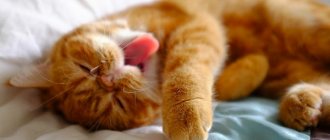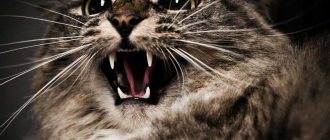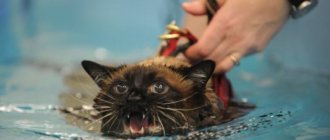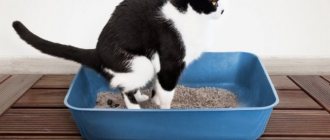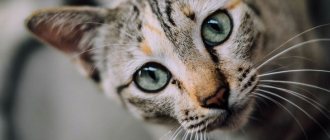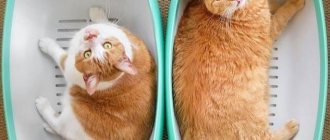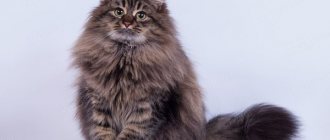If for a long time the owners notice that the cat has different pupils, they often suspect health problems. Depending on the symptoms, the cause may not only be an eye disease. A change in the cat's behavior and the obvious consequences of a blow as a result can lead to irreversible consequences if the size of the pupil is not monitored in time.
What is anisocoria?
In cats, the pupil is an elliptical hole in the middle of the iris that allows light to pass through the eyeball to the retina. The pupil constricts or dilates (enlarges) depending on the amount of light entering the eye, with both pupils typically dilating in dim light and constricting in bright light.
Anisocoria is a condition in which the two pupils of a cat's eye are different sizes.
; in other words, one pupil is larger than the other. In some cases, the abnormal pupil may be the one that is smaller, and in other cases, the abnormal pupil may be the one that is larger.
Cats have different pupil sizes. Why do cats have different pupils?
Cat owners should be attentive to their pets: if you see anything incomprehensible in their behavior or physical condition, you should go to a specialist. If the owner sees different pupils in a cat, this may mean the consequences of a blow to the head or cerebral vascular disease in the animal.
When a veterinarian notices different pupils in a cat during a routine examination, he first asks the owner about the animal’s behavior and physical condition. Pets can get into fights with those who live nearby and get some kind of injury from them; a cat can simply hit its head when falling and get a slight concussion. Due to minor injuries, sometimes there is an uneven constriction or dilation of the cat's pupils, which usually returns to normal after a couple of hours.
By carefully observing his pet, the owner can see that the cat's different pupils are gradually becoming the same. If this does not happen a day after the blow, you should take the animal to a specialist and conduct an examination. You need to understand that you will probably need to visit your feline ophthalmologist. Specialists of this profile can be found in large cities, but in the provinces this is unlikely to happen, so you need to trust a veterinarian you know, who can also give good advice.
Sometimes, the cause of the disease can be identified through a routine examination and blood test, especially if the cat has different pupils due to a disruption in the functioning of the nervous system. In such cases, it will be enough to give the pet medications prescribed by the doctor for some time, and the cat should have a calm corner in which it is not threatened with any nervous shocks. If there are other animals living in the apartment that haunt the sick person, it is advisable to move her into a separate room. If necessary, the veterinarian will prescribe eye drops, which will need to be instilled at a certain time; cats do not like such procedures, so an assistant will be needed.
In cases where a cat's pupils suddenly become different, the veterinarian may suspect that the animal was hit on the head or there was a fight with an opponent; after two or three hours, when the stress passes, the eyes should become the same.
Animals kept for commercial purposes, for the production and subsequent sale of offspring, are periodically examined by a veterinarian. If he finds pupils of different sizes in a cat, it is advisable to seek the help of a feline ophthalmologist to find out the cause of this phenomenon. After a certain age, pets may develop various diseases, including eye diseases; an inflammatory process inside the eye or a tumor is quite possible.
An experienced veterinarian, through a blood test and visual examination, may well discover that the animal is undergoing an inflammatory process; sometimes appropriate medications relieve inflammation and the pupils become normal. In some cases, drops are prescribed that can narrow a dilated pupil or dilate a narrowed one. If there is no improvement, a more thorough examination is necessary.
There are known cases where pupils of different sizes in a cat were observed due to cancer; untreated cancer gives metastases to various organs, including the brain, which is why a similar effect occurs. The underlying ailment should be treated, and the size of the pupils will return to normal, if this is possible. Pets, like people, can develop a stroke, which also has a negative impact on the eyes. Making an accurate diagnosis is possible only after a thorough examination; a general veterinarian is simply not able to do this without special equipment. Therefore, if treatment does not bring relief, you should look for a clinic that has all the equipment to check the health of a sick cat, and specialists who can make the correct diagnosis.
Sometimes different pupil sizes in a cat occur due to minor injuries or stress; in such cases, the phenomenon goes away after a few hours and does not leave negative consequences; it is enough to provide the animal with a calm environment.
When changes in the pupils do not occur instantly, but gradually, a serious illness should be suspected, it could be a brain tumor, retinal detachment or another ailment; only a specialist can make an accurate diagnosis after a thorough examination.
What causes anisocoria?
“Anisocoria occurs suddenly and you should seek veterinary attention immediately.”
Anisocoria is a symptom, and there can be several different causes, including:
- Corneal injuries, such as corneal ulcers
- Disease or damage to the brain or nerves leading to eye damage
- Glaucoma, a disease in which the pressure in the eyeball increases (the pupil in the affected eye will be dilated)
- Uveitis, or inflammation of the inside of the eye (the pupil in the affected eye will usually be narrowed)
- Retinal diseases
- Formation of scar tissue between the iris and lens (posterior synechia), a condition that can develop after uveitis
- Iris atrophy, or reduction in the amount of tissue in the iris, usually a degenerative change associated with aging
- A congenital iris defect in which the iris tissue does not develop properly
- Eye cancer
- Spasmodic pupil syndrome is a syndrome that may be associated with infection with feline leukemia virus.
If anisocoria occurs suddenly, you should treat it as an emergency and seek veterinary care immediately to reduce the chance that your cat's vision will be permanently lost.
One pupil is larger than the other: normal or pathological?
Anisocoria is a pathological condition in which one pupil is larger than the other, and its obvious deformation is possible. It is very simple to determine the disease visually; you just need to focus your gaze on any stationary object: one pupil naturally narrows and dilates, and the second remains motionless and incapacitated. The problem is obvious and must be treated.
Most often, this pathology progresses in childhood, and the task of caring parents is to promptly determine the characteristics of the child’s gaze and, together with an ophthalmologist, find out why one pupil is larger than the other. Cases of the disease in adult patients are also known.
Causes of different pupils
This disease is diagnosed infrequently, and many patients prefer to ignore the problem, citing a hereditary factor, racial characteristics, or their own uniqueness. This is a fundamentally wrong approach: if one pupil is larger than the other, the reasons, or rather their identification, will help normalize this pathological condition and maintain maximum visual acuity.
Important! Any change in the shape or size of one pupil relative to the other is a reason to urgently consult a doctor!
Among the predisposing factors it is worth highlighting:
- trauma and microtrauma of the eyeball, individual muscle groups;
- damage to the oculomotor nerve;
- cerebrovascular accident;
- malignant tumor;
- brain damage;
- aneurysm;
- herpes zoster;
- Eydi syndrome;
- tonic pupil;
- hereditary factor.
If the pathology progresses in a mild form, then the pupil of one eye is only slightly larger than the other, and does not entail serious complications. For example, a person’s lymph node becomes inflamed due to a cold; as a result of this process, a clinical picture cannot be excluded where one pupil is dilated more than the other. After recovery, the symptom disappears on its own.
That is why it is important to determine the etiology of the pathological process together with the attending physician, who will prescribe effective conservative treatment and eliminate the risk of complications.
Symptoms of the disease
Alarming symptoms include the following anomalies:
- blurred vision;
- photophobia;
- double vision;
- migraine;
- fever;
- acute pain syndrome in the eyes;
- nausea, less often – vomiting;
- torticollis;
- partial loss of vision;
- decline in performance.
If one pupil is slightly larger than the other, then this abnormal condition is immediately visible. At first, the patient may not pay attention to such a cosmetic defect, but subsequent symptoms raise serious concerns for his vision.
If such discomfort prevails, it is necessary to urgently seek qualified help from an ophthalmologist. If we are talking about a childhood disease, then the difference in pupils is already a good reason to go to a specialist.
Diagnosis of the disease
History data is not enough to find out why one pupil is large and the other is small. Additionally, diagnostics is required, which includes a number of clinical examinations.
These are:
- MRI;
- CT head;
- tonometry (excludes glaucoma);
- X-ray of the neck and head.
Additionally, laboratory tests are required, which include:
- blood analysis;
- cerebrospinal fluid analysis.
Only such an integrated approach makes it possible to determine why one pupil has become larger than the other, if such a pathology was not observed quite recently.
Effective treatment
There is no treatment as such, since it is important to eliminate not the symptoms, but the root cause. That is why it is very important to know what preceded this pathology and after what events it progressed.
Anisocoria against the background of systematic migraine attacks requires additional use of anticonvulsant, antibacterial and analgesic drugs.
The doctor should select medications only after determining why one pupil is larger and the other smaller.
The treatment is carried out by a narrow specialist - a neurologist, but in the absence of timely treatment measures, serious health complications, even death, cannot be ruled out. For example, when one pupil is larger than the other against the background of bacterial meningitis, the patient may die unexpectedly, and the therapy will not give positive dynamics with the infection rapidly progressing in the body.
Important! If one pupil is larger than the other, there should be no self-medication, since such an anomaly can be a symptom of a fatal disease.
Additional conservative treatment includes taking corticosteroids and antitumor drugs, which are again selected by the doctor on a strictly individual basis.
With a correctly selected treatment regimen, noticeable improvements and changes in vision are observed after a short period of time, and the problem where one pupil is slightly larger than the other no longer bothers the patient (his parents).
It is important to understand that superficial self-medication will only do harm, and failure to understand the problem can lead to an advanced clinical picture and serious complications for the patient’s health.
How is the underlying cause of anisocoria diagnosed?
Your veterinarian will begin with a physical examination of your cat, including a detailed examination of the eye structures. Depending on these preliminary results, your veterinarian may perform additional, more specific testing. Your veterinarian ophthalmologist can measure tear production and intraocular pressure (pressure in the eyes) for each eye. The cornea may be stained with fluorescein dye to identify underlying corneal lesions or ulcers, and a conjunctival scraping or biopsy may be obtained and sent to a diagnostic laboratory for specialized testing. Blood tests may be performed to determine if the problem is due to a systemic disease such as feline leukemia.
In some cases, your veterinarian may recommend a referral to a specialized veterinary ophthalmologist for further diagnostic testing.
Associated symptoms
Pathologies develop over time and are accompanied by additional symptoms. If a cat has pupils of different sizes, it often reacts to light with only one eye. Intense tearing, redness or clouding of the cornea causes pain and discomfort. She may reflexively squint if there are problems in the functioning of the eyelids. If your cat has poor coordination of movements and is vomiting, poisoning from toxic plants or drugs is possible.
An active lifestyle puts a kitten in danger; you need to pay special attention to its behavior after a fight with other animals or falls from a height. Often a concussion is accompanied by loss of consciousness and, as a consequence, memory loss. Having woken up, the pet does not recognize the owner, hisses, behaves inappropriately, and tries to hide in hard-to-reach places. If the cat came from the street, and upon examination the owner noticed hematomas, bruises, bruises on the head or neck, redness of the mucous membranes or convulsions, it is necessary to urgently contact a veterinarian.
If with such a symptom the animal has become lethargic, then this is worth paying attention to.
Symptoms indicating a stroke deserve increased attention:
- unnatural head tilt;
- loss of balance;
- loss of appetite, lethargy, spontaneous bowel movements;
- paralysis of the paws on one side of the body;
- vomiting or epileptic seizure.
Return to contents
Good to know
- Anatomy of the liver in cats
- The structure and functions of the thyroid gland in cats
- Measuring blood pressure in cats before general anesthesia
- Current role of dexmedetomidine in clinical veterinary anesthesia and intensive care
- Dynamic testing of thyroid function in cats
- Gabapentin in cats and dogs (all pros and cons, indications, contraindications, doses, features of use, instructions for use)
- Information content of hematological and echocardiographic preoperative screening indicators
- Historical background on hyperthyroidism in cats
- Hyperthyroidism in older cats
- Cardiac hypertrophy in domestic cats
- Analysis of anamnestic data during preoperative examination of small domestic animals
- Study of anamnestic data in cats that require manipulation under general anesthesia
- Method for measuring blood pressure in cats
- ICD in cats (diagnosis and symptoms)
- Hyperthyroidism is suspected, but serum T4 concentration is normal
- Acute gastroenterocolitis in dogs (etiology, pathogenesis, diagnosis and treatment)
- Reducing mortality during anesthesia is an important task of veterinary anesthesiology
- Thrombosis in cats (general information, etiology, pathogenesis, clinical picture, diagnosis and treatment)
- Urolithiasis of small animals (etiology, pathogenesis, diagnosis and treatment)
- Congestive cardiomyopathy in cats (What is it? How to protect your pets)
- Gastrointestinal tract in dogs (anatomy and physiology)
- Levofloxacin in pets
- Concentrations of total and free thyroxine in cats (T4 hormone)
- Surgical treatment for hyperthyroidism in cats
- Treatment and prevention of urolithiasis in animals
- Urinary tract stones in cats and dogs (causes and mechanisms of formation)
- Liver lipidosis in domestic cats (symptoms and treatment)
- Performing laboratory tests in cats with hyperthyroidism
- Treatment of hepatolipidosis in domestic cats
- Pathogenesis and colloid theory of stone formation in urolithiasis
- What preparation is necessary for a cat to undergo general anesthesia?
- Causes of stone formation in dogs and cats
- Ondansetron for dogs (mechanism of action, blockade of serotonin receptors)
- Urolithiasis in Russia (urolithiasis). Scourge of modernity
- Acute gastroenteritis in dogs (pirchinas, pathogenesis, diagnosis and treatment)
- What function does the liver perform in the body of animals and humans?
- Misdiagnosis of hyperthyroidism based on falsely high serum total T4 (or free T4) concentration
- Drugs for the treatment of hypertension associated with hyperthyroidism in cats
- Primary Cardiomyopathy in Cats (History, Causes, Pathogenesis)
- Pharmacological treatment of cats with hyperthyroidism
- Endogenous hyperthyroidism in cats (causes, definition, characteristics)
- Monitoring during anesthesia in cats (Why is this necessary?)
- Methods of thoracic radiography in cats during pre-anesthesia diagnosis
- Preoperative assessment of the physiological status of the animal’s body
- The role of additional diagnostic methods before anesthesia in cats
- ECHO examination in cats before planned interventions using anesthesia
- Echocardiographic diagnosis of myocardial diseases in cats
- Carrying out electrocardiographic diagnostics in cats
- Why is etamzilat prescribed?
- Performing a physical examination during surgery in cats
- Physiology of the thyroid gland in domestic animals
- The role of cardiac evaluation as part of the preoperative workup in cats
- Description of the thyroid gland (history and functions)
- The role of animal examination and clinical examination during preoperative screening examination
- Information content of palpation of the thyroid gland in cats
- Use of the antibiotic cefotaxime
- Instructions for the use of propofol in dogs and cats and other animal species
- Prevalence of liver disease in cats
- Restrictive myocardial diseases in cats (definition, diagnosis and therapy)
- Heart murmurs in cats (How to interpret? Diagnostic value of this symptom?)
- Symptoms of urolithiasis in pets
- The state of internal organ systems in healthy dogs
- Radioactive iodine therapy for cats with hyperthyroidism
- Tiletamine and zolazepam are a drug for non-inhalation anesthesia in dogs and cats.
- What thyroid hormones circulate in the blood plasma of animals?
- Informativeness of determining thyroid-stimulating hormone in cats
- Ceftriaxone is a cephalosporin group of antibiotics
- Ultrasound technique of the thyroid gland in domestic cats
Play, hormone!
One of the safest reasons that provokes a dilated pupil in a cat is high hormonal activity. During the rutting period, not only the physiological indicators of tailed animals change dramatically, but also their habits. Can't understand why your cat's pupils are dilated? Take a closer look at her behavior.
During the period of heat, the cat behaves so eloquently that it is simply impossible not to notice it:
- crawling on the floor on your stomach;
- loud inviting meow;
- purring and “wiping” all protruding parts of the furniture;
- frequent visits to the litter box;
- the animal's tail is constantly thrown up and to the side;
- pussy licks genitals all the time;
- many switch to breathing through their mouths, leaving their nose free to sniff out their prospective girlfriend.
Reviews from owners eloquently indicate that during this period, owners simply do not have time to think about why the cat has dilated pupils. They are more concerned about the urgent search for a “groom” for their pet or rush around in search of drugs that reduce sexual activity.


